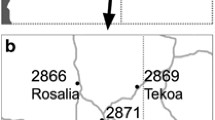Summary
1. The basic haploid chromosome number in the genusTulipa is 12. Polyploid series occur in both the subsections Eriostemones and Leiostemones.
2. Although the diploid species probably reproduce sexually in the wild, the polyploids must be purely clonal since no aneuploids have been found.
3. Two main types of change have affected the chromosome morphology of the genus. Genotypic change of size and regulated structural change altering the position of the centromere have separated the genus into three groups with large, medium and small chromosomes. Random structural change has produced complements with reduplicated fragments (T. galatica) and with clearly unmated chromosomes (T. Gesneriana var. Zomerschoon).
4. Evidence from external and chromosome morphology, from intersterility and from the time at which meiosis occurs, points to the conclusion that the subgroupClusiana of the Leiostemones is as distinct from the other subgroups as it is from the Eriostemones.
Similar content being viewed by others
References
Darlington, C. D. (1929). “Structural hybridity in the Tradescantiae.”J. Genet. 21, 207–86.
-- (1932a).Recent Advances in Cytology. London.
—— (1932b). “The control of the chromosomes by the genotype.”Amer. Nat. 66, 25–51.
Hall, Sir A. D. (1929).The Book of the Tulip. London.
-- (1936). “Polyploidy inTulipa.”J. Linn. Soc. (in the Press).
La Cour, L. (1931). “Improvements in everyday technique in plant cytology.”J. Roy. micr. Soc. 51, 119–26.
Mather, K. (1936). “Cytological studies inPrunus.”Genetica (in the Press).
Mol, W. E. de (1929). “The originating of 2x and 4x pollen grains in Duc van Thol tulips,T. suaveolens, dependent upon the method of culture applied.” Ibid.11, 119–212.
Nawaschin, M. (1926). “Variabilität des Zellkerns beiCrepis-Arten.”Z. Zellforsch. 4, 171–215.
Newton, W. C. F. (1927). “Chromosome studies inTulipa.”J. Linn. Soc. 47, 339–54.
Newton, W. C. F. &Darlington, C. D. (1929). “Meiosis in Polyploids. I.”J. Genet. 21, 1–56.
Randolph, L. F. (1935). “A new fixing fluid and a revised schedule for the paraffin method in plant cytology.”Stain Tech. 10, 3.
Author information
Authors and Affiliations
Rights and permissions
About this article
Cite this article
Upcott, M., La Cour, L. The genetic structure ofTulipa . Journ. of Genetics 33, 237–254 (1936). https://doi.org/10.1007/BF02982534
Issue Date:
DOI: https://doi.org/10.1007/BF02982534




